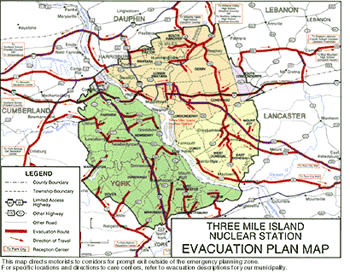SOARCA Process, Step 4: Modeling Emergency Response
In the unlikely event that a severe accident resulted in a release of radioactive material from a nuclear power plant, the plume of radioactive material would disperse from the site into the environment by expanding and moving downwind. In conjunction with modeling offsite release of radioactive material in Step 3 of the State-of-the-Art Reactor Consequence Analyses (SOARCA) process, the project team modeled the implementation of emergency plans during a severe accident. To learn more, see the following topics on this page:
Emergency Preparedness and Its Importance to SOARCA
To reduce the consequences of a radiological event, the U.S. Nuclear Regulatory Commission (NRC) requires each site to demonstrate reasonable assurance that adequate protective measures can and will be taken in the event of a radiological emergency. Examples of NRC requirements include periodic exercises of emergency response capabilities, providing and maintaining adequate emergency response facilities and equipment, and establishing procedures to notify state and local response organizations and emergency personnel.
In order to protect public health and safety in the event of a radiological accident and to meet these requirements, the facilities develop emergency preparedness (EP) programs. Nuclear power plant EP programs include plans, training, exercises, and resources designed to protect public health and safety in the event of a radiological accident. These EP programs are developed, tested, and evaluated and are in place as another level of defense to protect the public. (For additional detail, see Emergency Preparedness and Response.)
Emergency Response
The project team used MACCS2 (MELCOR Accident Consequence Code System, version 2) to realistically model the exposure of the surrounding population. To do so, MACCS2 integrated a simulated evacuation and other protective actions with the atmospheric transport and dispersion model. For greater realism, the team created models with network evacuations. The network evacuation model is based on the routes of the planned site evacuation. The map to the right depicts representative routes for a planned site evacuation.

For the purposes of evaluating accident consequences in the SOARCA project, the most evident part of a plant's emergency response plan is the evacuation of the public in the 10-mile (16-km) plume exposure pathway Emergency Planning Zone (EPZ). Actions in this EPZ could be expanded if the plume projections suggest that the population in a wider area need to take protective actions. Thus, the project team assessed additional aspects of emergency response, including relocation from areas of relatively high potential for exposure, as well as variations of evacuation and sheltering of population groups outside the 10-mile EPZ to a distance of 20 miles from the plant.
This step of the SOARCA process also recognized that offsite response organizations (OROs) will take necessary actions as detailed in their offsite emergency plans to reduce the risk to the public in the unlikely event of an accident. Consequently, the project staff obtained site-specific information from OROs to support protective action timelines for use in the models. In addition, the licensees provided evacuation time estimates (ETEs) and other relevant information. These ETEs provided a significant level of detail, including the evacuation characteristics of several segments of the public, known as "cohorts," predicted to behave in a similar fashion following an accident.
Page Last Reviewed/Updated Tuesday, October 08, 2024
Page Last Reviewed/Updated Tuesday, October 08, 2024

